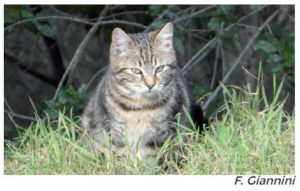 Common name: Feral domestic cat
Common name: Feral domestic cat
Scientific name: Felis catus
Brief description: The domestic cat derives from the African wild cat, whose domestication appears to have occurred around 9000 years ago for the control of rodents. All domestic animals have always represented a valid aid for man, and the same is true for the cat, now a companion animal. Unfortunately, however, if abandoned or set free without further contact with man it regains its feral “status” and can pose a risk to its prey, especially if they are rare and endemic species.
Biology and ecology: The domestic cat, once it has become feral, takes on ecological and behavioural characteristics that are highly similar to the wild species and as such it becomes an excellent predator. The cat is essentially carnivorous, while insects and plants make up only a tiny part of its diet.
Distribution in the Tuscan Archipelago and introduction: Feral cat populations are present in Capraia, Elba, Giglio and Pianosa, while the situation in Gorgona is uncertain, where there are numerous free domestic cats in the town. They are however absent in Giannutri and Montecristo.
Impact: The impact of a carnivore such as the cat in fragile island ecosystems can have dramatic consequences. In these contexts the most susceptible species to predation are maritime birds, but also the multitude of species of passerine birds that stop on the Mediterranean islands during long migratory flights in spring and autumn. The feral cat can be a very serious threat to the survival of colonies of seagulls and shearwaters, especially as they nest on the ground and do not have defences against this land predator.
Management in protected areas: At Pianosa the feral cat is already subject to regular transfer operations which have allowed the population to be maintained at relatively low levels. With the project “Resto con Life” the Park hopes to be able to move all individuals, in order to protect the native species threatened by the presence of this feline.




